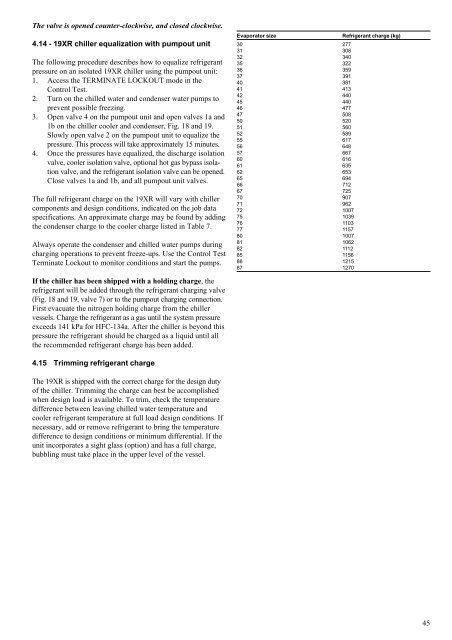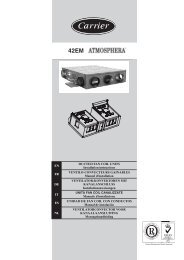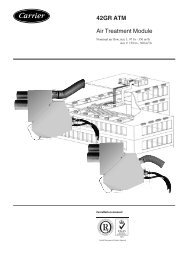19XR (PIC II) Hermetic Centrifugal Liquid Chillers 50 Hz - Carrier
19XR (PIC II) Hermetic Centrifugal Liquid Chillers 50 Hz - Carrier
19XR (PIC II) Hermetic Centrifugal Liquid Chillers 50 Hz - Carrier
Create successful ePaper yourself
Turn your PDF publications into a flip-book with our unique Google optimized e-Paper software.
The valve is opened counter-clockwise, and closed clockwise.<br />
4.14 - <strong>19XR</strong> chiller equalization with pumpout unit<br />
The following procedure describes how to equalize refrigerant<br />
pressure on an isolated <strong>19XR</strong> chiller using the pumpout unit:<br />
1. Access the TERMINATE LOCKOUT mode in the<br />
Control Test.<br />
2. Turn on the chilled water and condenser water pumps to<br />
prevent possible freezing.<br />
3. Open valve 4 on the pumpout unit and open valves 1a and<br />
1b on the chiller cooler and condenser, Fig. 18 and 19.<br />
Slowly open valve 2 on the pumpout unit to equalize the<br />
pressure. This process will take approximately 15 minutes.<br />
4. Once the pressures have equalized, the discharge isolation<br />
valve, cooler isolation valve, optional hot gas bypass isolation<br />
valve, and the refrigerant isolation valve can be opened.<br />
Close valves 1a and 1b, and all pumpout unit valves.<br />
The full refrigerant charge on the <strong>19XR</strong> will vary with chiller<br />
components and design conditions, indicated on the job data<br />
specifications. An approximate charge may be found by adding<br />
the condenser charge to the cooler charge listed in Table 7.<br />
Always operate the condenser and chilled water pumps during<br />
charging operations to prevent freeze-ups. Use the Control Test<br />
Terminate Lockout to monitor conditions and start the pumps.<br />
If the chiller has been shipped with a holding charge, the<br />
refrigerant will be added through the refrigerant charging valve<br />
(Fig. 18 and 19, valve 7) or to the pumpout charging connection.<br />
First evacuate the nitrogen holding charge from the chiller<br />
vessels. Charge the refrigerant as a gas until the system pressure<br />
exceeds 141 kPa for HFC-134a. After the chiller is beyond this<br />
pressure the refrigerant should be charged as a liquid until all<br />
the recommended refrigerant charge has been added.<br />
4.15 Trimming refrigerant charge<br />
The <strong>19XR</strong> is shipped with the correct charge for the design duty<br />
of the chiller. Trimming the charge can best be accomplished<br />
when design load is available. To trim, check the temperature<br />
difference between leaving chilled water temperature and<br />
cooler refrigerant temperature at full load design conditions. If<br />
necessary, add or remove refrigerant to bring the temperature<br />
difference to design conditions or minimum differential. If the<br />
unit incorporates a sight glass (option) and has a full charge,<br />
bubbling must take place in the upper level of the vessel.<br />
Evaporator size Refrigerant charge (kg)<br />
30 277<br />
31 308<br />
32 340<br />
35 322<br />
36 359<br />
37 391<br />
40 381<br />
41 413<br />
42 440<br />
45 440<br />
46 477<br />
47 <strong>50</strong>8<br />
<strong>50</strong> 520<br />
51 560<br />
52 589<br />
55 617<br />
56 648<br />
57 667<br />
60 616<br />
61 635<br />
62 653<br />
65 694<br />
66 712<br />
67 725<br />
70 907<br />
71 962<br />
72 1007<br />
75 1039<br />
76 1103<br />
77 1157<br />
80 1007<br />
81 1062<br />
82 1112<br />
85 1156<br />
86 1215<br />
87 1270<br />
45




